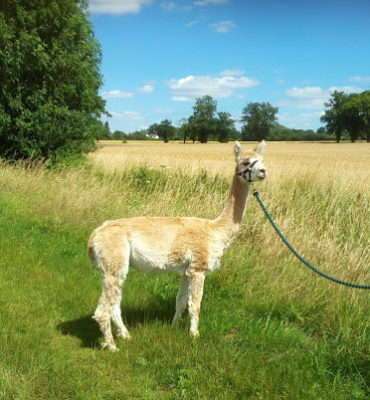![]() Neatly stacked in the corner of our kitchen are several plastic clip boxes containing 50g balls of alpaca yarn. Every now and again I have to go over and check that they are still as soft as the first time I held them. They are, and it makes my heart leap every time.
Neatly stacked in the corner of our kitchen are several plastic clip boxes containing 50g balls of alpaca yarn. Every now and again I have to go over and check that they are still as soft as the first time I held them. They are, and it makes my heart leap every time.
It is almost a year since we walked into the Farm Business Innovation Show, innocent of the charms of alpacas, and set on adding goats to our growing diversification plans. We had been talking about grazing the meadow opposite the campsite as part of its management, whilst at the same time farming a product that we could use or sell. Alpacas had been mentioned a couple of times but I couldn’t really see the point in them. What do they actually do, other than look a bit odd? In any case, they are not a proper farm animal. And then we walked along an aisle at the far corner of the Show and I met one.
I am pretty sure that they have magic powers, as the minute that you meet an alpaca you are immediately convinced that it doesn’t matter that there might not be a point to them, you are going to let them into your life anyway. As it turns out they are almost the perfect farm animal – as my farmer father had been subtly suggesting for months – and have a huge amount to offer.
I came home from the Show clutching a flyer for an alpaca business in Oxfordshire and booked an ‘Introduction to alpacas’ course with them for two weeks later. On that one day course in mid November I learnt that alpacas are incredibly curious, intelligent and gentle animals (most of the time), and produce one of the finest, most luxurious fibres in the world. They also enjoy a walk in the countryside and hum to communicate.
I admit I had already checked the ‘for sale’ list on the alpaca farm website. So when I turned up at the course I was able to identify Dumbledore, our white suri alpaca, out of a group of young alpacas that we were working with. The fact that I managed to spot him meant that A. I had been spending far too much time in the past two weeks looking at alpacas, and B. I felt that we had connected and I had to give him a home. In the end he came to us with two other two year old alpacas, Sting and Sky Thunder.
At this point, in late November 2016, we had a field but no fencing, or shelter, or water. Luckily the boys were able to stay in their current home until we had sorted all of the above, but it took longer than we thought due to a last minute, and it turns out wise, decision to replace the field drains before we went any further. It did give me time to find Ben, our fourth alpaca, at a farm just down the road. It was love at first sight and he has turned out to be our calm, intelligent and protective herd leader.
All four boys finally arrived in April this year and proved themselves very capable of of keeping the meadow grass cut and the traffic speed down on the road that passes our farm. They have also been highly successful at putting smiles on the faces of many campers who have taken a stroll with them along the green lane beside the farm.
But the most exciting moment in our alpaca journey so far has to be the first time that we saw our ‘end product’. We sent all four fleeces from our boys to East Anglia Alpaca Mill near Norwich, where they were lovingly washed, scoured, carded, gilled and spun into beautifully soft DK yarn. Each fleece has been individually processed so that we have balls of yarn in their natural colours from each alpaca. It is already in the hands of people far more talented than me and according to my friend Anne it is knitting up well so far!
So now, as we approach this year’s Farm Business Innovation Show, we have a new alpaca walking business on the farm, some fabulous alpaca yarn for sale…oh, and did I mention Gemini, Genesis and Fabian, the three new additions to the alpaca team?









